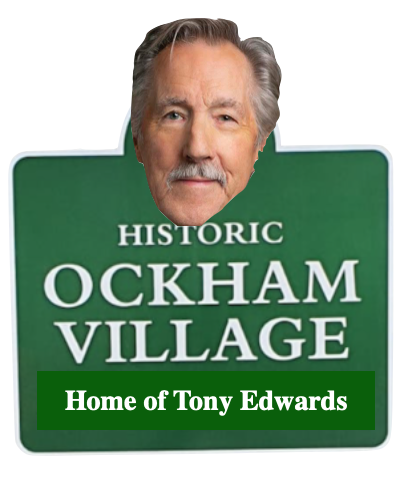 Abraham Lincoln
If given the truth, the people can be depended upon to meet any national crisis...
Abraham Lincoln
If given the truth, the people can be depended upon to meet any national crisis...
 Guildford news...
for Guildford people, brought to you by Guildford reporters - Guildford's own news service
Guildford news...
for Guildford people, brought to you by Guildford reporters - Guildford's own news service
Ockhamite Diary: What’s the Best Investment – Classic Cars, Land or Pepper Mills?
Published on: 2 Dec, 2022
Updated on: 5 Dec, 2022
 A sidelong glance at the world from Tony Edwards…
A sidelong glance at the world from Tony Edwards…
Restaurant bills as big as pepper mills
A jaw-dropping, metre-long pepper mill hovered menacingly above my spaghetti vongole at an Italian restaurant in Knightsbridge last week, operated by a smiling waiter who later served-up a bill of equally mammoth proportions after the tiramisu and coffee.
So although there are no official statistics to back this up, I’m fairly sure the size of your restaurant bill will be in direct proportion to the size of its pepper mills. The bigger the grinder – the larger your bill.
But unlike the so-called ‘cover charge’ – the tax which restaurants charge you for the privilege of sitting on their chairs – the pepper mill at least serves a useful purpose and has an interesting history, even if its primary purpose these days seems to be to embarrass female diners.
You may be interested to know that the phallic-shaped device was dreamed-up by the Peugeot brothers in 1842, well before they started making their famous Peugeot cars, and at a time when peppercorn was painstakingly ground by hand with a mortar and pestle.
Since then, as you’ll have noticed, pepper mills have been getting steadily larger at roughly the same rate as nouvelle cuisine has been getting fashionably smaller – served-up, these days, as little more than colourful graphics on extra-large plates.
So I’d guess most of us would probably wince at the prospect of a bill from a restaurant in Ontario, Canada, which boasts the world’s largest pepper mill. It’s a 4.98 metres long monster (16 ft 4 inches in old money), as verified by Guinness World Records.
But rumours of an even larger pepper mill (20 ft plus they claim), in use at a Manhattan restaurant should be taken with a pinch of salt. It takes four people to operate it.
Money you don’t need to spend
Money can buy you a mountain of press publicity without it ever leaving your bank account, as Joe Lycett proved last week.
The comedian hit the headlines by seemingly mincing-up £10,000 in an industrial size shredder before revealing that no money was involved and admitting he’d destroyed a couple of wads of waste paper instead.
If he hadn’t fooled the media into thinking he’d destroyed his £10,000, they’d have almost certainly ignored the stunt and his underlying LGBT message. But, by the time he spilled the beans, he’d already been in the headlines for two days on the trot, proving that it was the perception of money that mattered – not the cash itself.
A 1950’s film revolved around a very similar perception of wealth. The Million Pound Note told the story of a man (played by Gregory Peck) who could buy almost anything without spending a penny because his £1 million note (Known as a Titan) was proof of his creditworthiness.
A credible remake of the film in 2022, allowing for current levels of inflation, would probably be called The Hundred Million Pound Note.
But I don’t go along with the old adage that money can’t buy happiness: it almost certainly can. Shed loads of money would fund the laboratories and salaries of a massive research team to discover ways of producing ‘happiness’ on an industrial scale – so job done for the
world at large.
Woken-up by an ‘un-woke’ prince
Once upon a time a company looking for cheap publicity carried out a survey which proved that otherwise well-adjusted 18-to-29-year-olds think traditional fairy stories are ‘inappropriate’, ‘old fashioned” and ‘offensive’.
Their survey says they were particularly ‘shocked’ and ‘dismayed’ by the fact that neither Snow White nor Sleeping Beauty gave their consent for a kiss from two very un-woke princes who woke them from their slumbers. And they weren’t at all happy with the idea that women needed to be ‘saved’ by men in the first place, according to press reports this week.
I feel sure it’s all just a bit of a misunderstanding in the telling of the tales. Clearly, both fairy tale ladies were having a pretty stressful time of it – what with the Queen planning to poison Snow White with a rotten apple and an evil witch stabbing Sleeping Beauty with a spinning wheel
spindle.
They probably passed out with the stress of it all. But then two princes, who were proficient in mouth-to-mouth resuscitation (and always carried their own CPR machines), turned-up to revive the two flagging ladies and, as a result, became social media heroes on Fairytale Facebook.
I can, of course, see why vegans might object to the wicked witch planning to eat Hansel and Gretal for supper, but I wouldn’t mind betting she settled for a mouth-watering veggie substitute instead. And they all lived happily ever after.
Well balanced at the bar
University researchers in Italy say the type of wines we drink can reveal our inner personalities.
Extroverts, we were told this week, list champagne as their top tipple while emotionally stable types go for full-bodied reds like a shiraz or cabernet sauvignon.
Agreeable people would probably raise their glasses to the complex bouquet of a Californian cabernet, according to the study by two teams from universities in Verona and Macerata, while highly conscientious individuals don’t show any particular wine preferences.
Disappointingly, the research makes no mention of balanced wine drinkers – those people who’ll say yes to a red, white, or rose, as long as they can have a glass in each hand.

Oliver Reed enjoys a glass of wine. Presumably, there was another in his left hand, or perhaps a bottle?
The legendary actor and hellraiser Oliver Reed was a fine example of a balanced drinker. His Surrey local was The Punchbowl in Oakwood Hill, near his Ockley home, where he regularly explained that he didn’t live in a world of sobriety so he liked to give his inhibitions a bit of a bath now and then. And his simple test to prove he wasn’t drunk was to lay on the floor “without holding on”.
The star of a host of films, including Gladiator, rarely drank water, protesting that fish peed in it. And he often quoted Benjamin Franklin who famously declared; “In wine there is wisdom, in beer there is freedom, but in water there is bacteria.”
No doubt he’d have been pleased to hear about new research this week from the University of Aberdeen which concluded that the previously recommended eight glasses of water a day may actually be too much for the human body – even harmful.
So you have been warned. Ollie Reed was right – water should be drunk in moderation and only when alcohol isn’t available.
A classic way to profits
I bought my very first car for £225 in 1961. It was an MG TC, reg no FPO 425, built 15 years earlier in 1946, but looking good for her age and still capable of up to 80 mph with luck and a following wind.
I should have kept it as they now fetch around £40,000.
I should also have kept a car I bought 10 years later in 1971 for £1,500. It was a 1966 Aston Martin DB6, reg no JYM 40D, one of only 142 ever made. They’re currently changing hands at around £500,000.
At the time both were merely “second-hand” cars but they were destined to become “valuable classics” All that was needed to, one day, cash-in on their rising value was a bit of foresight and a nice warm, dry barn for storage.
As I recalI, I had the foresight but not the barn. However, I don’t regret selling any of the classic cars. As any enthusiast will confirm, they cost a mint to maintain. But I regret not buying the barn (better still, lots of barns) as classic car storage became and remains a booming industry, while property, in general, has outperformed almost every other investment – with barns in short supply and in high demand.
The reality is that, while classic cars are an appreciating asset and a lot more fun, property still remains the best ‘classic’ investment.
As Mark Twain put it; “Buy land – they aren’t making it anymore.”
Buying up a London street
When Westminster City Council decided they’d rip up the York stone pavements on Carnaby Street, to replace them with some sort of geometric patterned, rubberised slabs, I put in a bid for the original paving slabs.
The plan was to break them up and auction off “Little bits of Carnaby Street” as a publicity stunt, linked to a fund-raising project for charity.
But the council jobsworths refused to let us have more than a dozen or so slabs – disposing of the rest as building waste.
We framed and marketed the York stone ‘bits’ through a niche company called Nothing of the Kind Ltd and I was pleased to discover this week that my then business partner still has one of them on the wall at his house in Japan.
“Visitors often ask what it is,” he says. “Most assume it’s a chip from a meteorite or even a bit of moon rock. But a few are disappointed when I tell them what it is as they’d heard the streets of London were paved with gold.”
Thought for the day
Such a shame that all the people who know how to run the country are too busy either driving taxi cabs or cutting hair.
Responses to Ockhamite Diary: What’s the Best Investment – Classic Cars, Land or Pepper Mills?
Leave a Comment Cancel reply
Please see our comments policy. All comments are moderated and may take time to appear. Full names, or at least initial and surname, must be given.Recent Articles
- Letter: I Would Rather Have Potholes Filled
- New Parish Councillor Says Funds from Developers Must Benefit the Local Community
- Tests at Paddling Pool Showed Water Was Too Alkaline, Says GBC
- Letter: Our Residents Want CIL Money Properly Used for Infrastructure Without Delay
- Charity’s New Programme Meets Needs of SEND Children Without School Places
- Pasta Evangelists to Open First Restaurant Outside London – Right Here in Guildford
- Police Seek Witnesses to Park Barn Assault
- Notice: Rosamund Community Garden
- Village School Set to Close Due to Falling Birth Rate
- Letter: Waverley’s Management of CIL Money Is Morally Questionable


Recent Comments
- Warren Gill on Millions of Taxpayer Money Recovered from Railway Fare Dodgers
- Roshan Bailey on Public Asked for Views on SCC’s Proposal for Reduced Speed Limits
- R Wong on Letter: Our Residents Want CIL Money Properly Used for Infrastructure Without Delay
- Nigel Keane on Village School Set to Close Due to Falling Birth Rate
- Patrick Bray on Public Asked for Views on SCC’s Proposal for Reduced Speed Limits
- Mark Percival on Public Asked for Views on SCC’s Proposal for Reduced Speed Limits
Search in Site
Media Gallery
Dragon Interview: Local Artist Leaves Her Mark At One of England’s Most Historic Buildings
January 21, 2023 / No Comment / Read MoreDragon Interview: Lib Dem Planning Chair: ‘Current Policy Doesn’t Work for Local People’
January 19, 2023 / No Comment / Read MoreA3 Tunnel in Guildford ‘Necessary’ for New Homes, Says Guildford’s MP
January 10, 2023 / No Comment / Read More‘Madness’ for London Road Scheme to Go Ahead Against ‘Huge Opposition’, Says SCC Leader
January 6, 2023 / No Comment / Read MoreCouncillor’s Son Starts Campaign for More Consultation on North Street Plan
December 30, 2022 / No Comment / Read MoreCounty Council Climbs Down Over London Road Works – Further ‘Engagement’ Period Announced
December 14, 2022 / No Comment / Read MoreDragon Interview: GBC Reaction to the Government’s Expected Decision to Relax Housing Targets
December 7, 2022 / No Comment / Read MoreHow Can Our Town Centre Businesses Recover? Watch the Shop Front Debate
May 18, 2020 / No Comment / Read More




















Carol Maidlow
December 3, 2022 at 3:10 am
Regarding the classic cars. The first car I purchased in the USA was a 1966 Chevy Malibu for $2,000 (a lot of money back then). Now they are classics selling for upwards of $40,000 in some places.